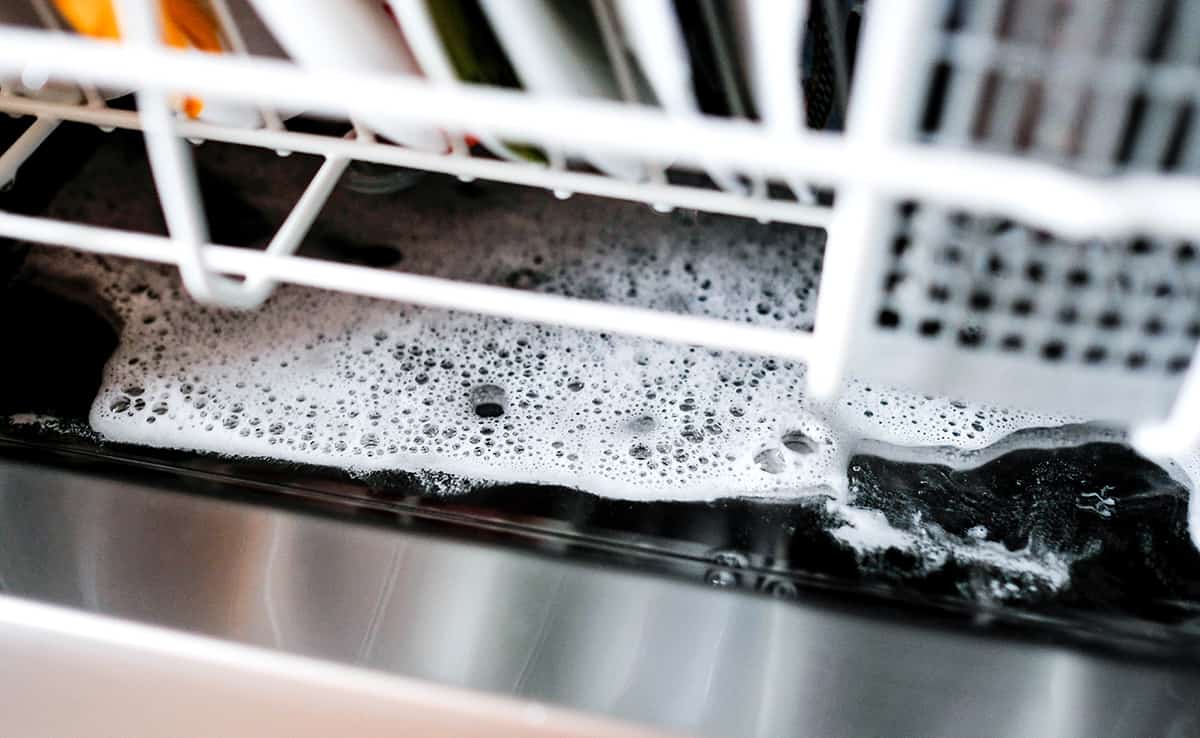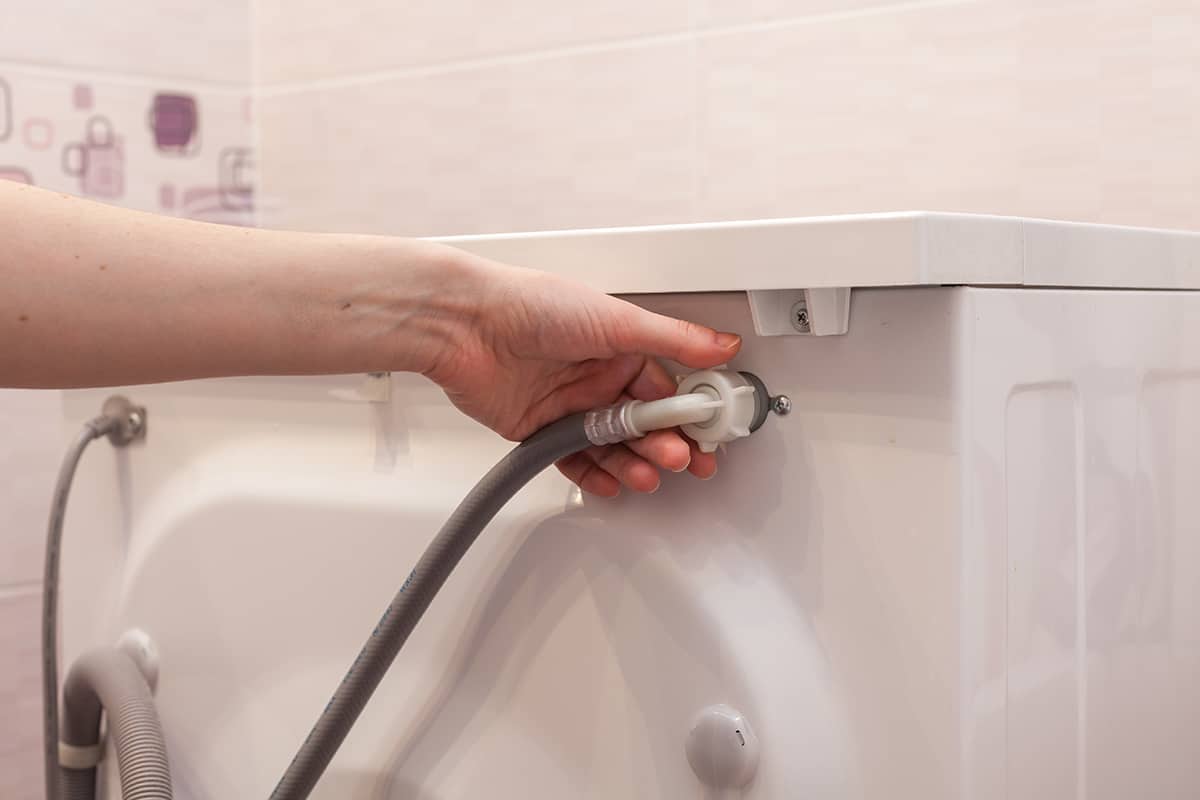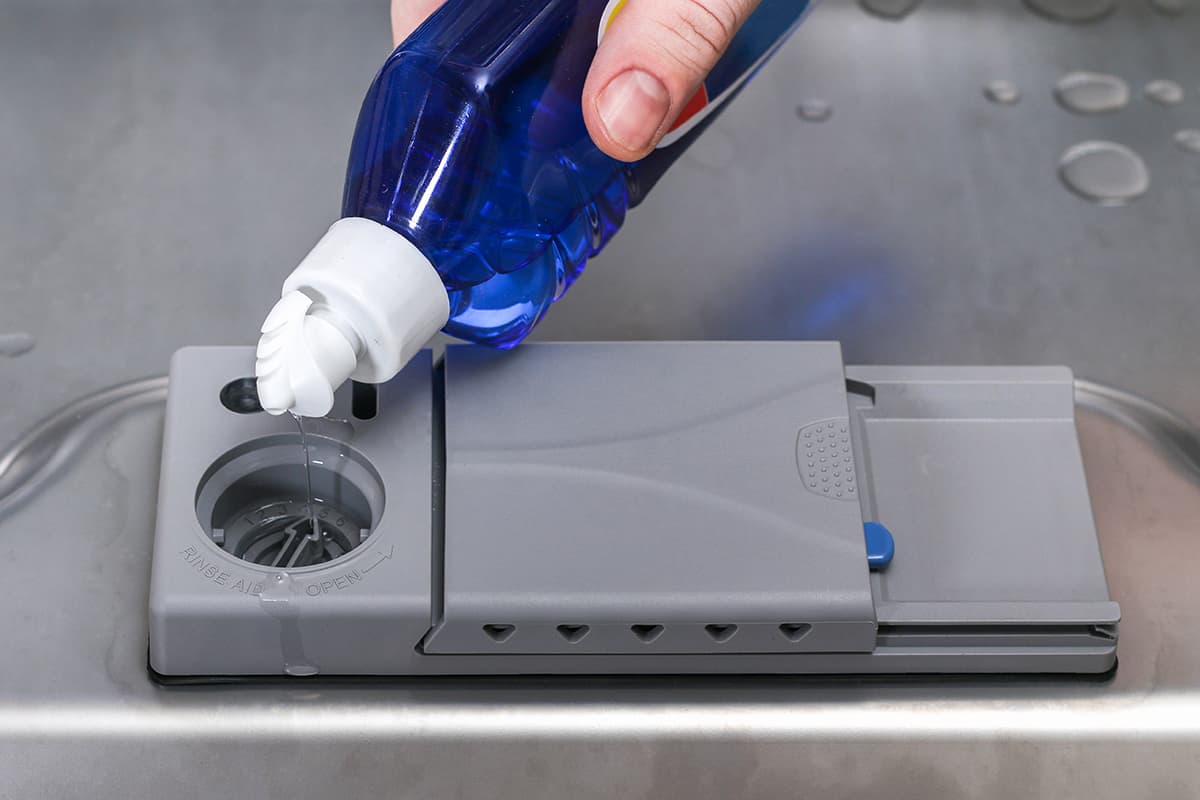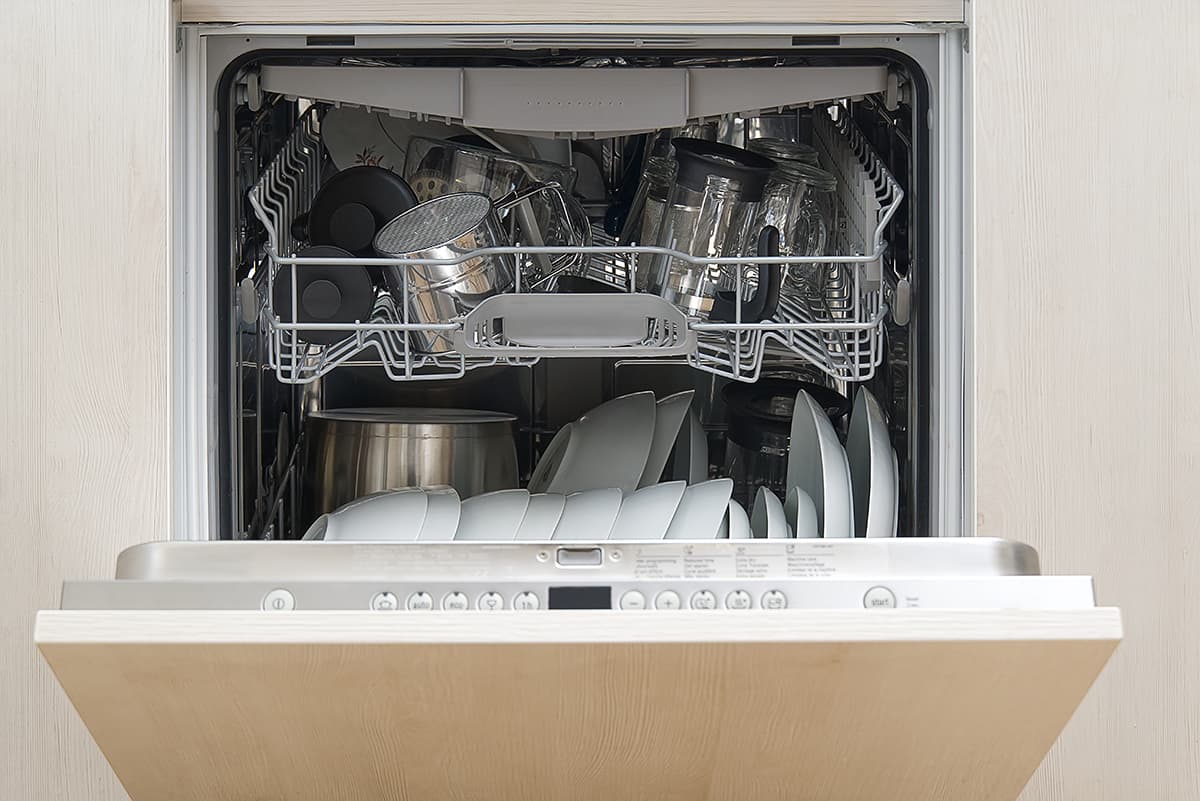A dishwasher is supposed to make your life easier by handling one of the most annoying household chores for you. However, when water starts pooling in the tub, you know you’re going to have a hard time.
These are the greatest causes of water pooling in the bottom of your dishwasher:
- Clogged filter
- Blocked drain hose
- Damaged or malfunctioning drain pump
- Faulty check valve
- Broken door seal
- Incorrect installation or leveling
- High water pressure
Today, we’ll take a closer look at the various causes of why water pools in the bottom your dishwasher, as well as explore the troubleshooting methods and what you can do to prevent this problem from happening again.
Causes of Water in the Bottom of a Dishwasher

In this section, we’ll dig deeper into the various causes of why your dishwasher is filled with water.
1. Clogged filter
One of the main reasons water can collect in the bottom of a dishwasher is a clogged filter. The filter catches food particles and other debris to stop them from blocking the drain. Over time, the filter can become full and prevent water from draining properly.
2. Blocked drain hose
The drain hose carries water from the dishwasher to your home’s plumbing system. Sometimes, small pieces of food or grease can build up and block the dishwasher hose. This blockage stops water from flowing out of the dishwasher, causing it to pool in the bottom.
3. Damaged or malfunctioning drain pump
The drain pump is a vital part of your dishwasher. It pushes water out of the dishwasher and into the drain hose. If the pump is damaged or not working correctly, it can’t remove the water, and it will stay in the bottom of the appliance.
4. Faulty check valve
A check valve is a small, one-way valve that stops dirty water from flowing back into the dishwasher. If the check valve is faulty, it won’t close properly, and dirty water can return to the dishwasher. This water can mix with clean water and cause a pool in the bottom of the machine.
5, Broken door seal
The door seal is a soft, flexible strip that goes around the dishwasher door. It keeps water inside the dishwasher while it’s running. If the door seal is broken or worn out, water can leak out of the dishwasher and pool in the bottom. This can also lead to water damage on your kitchen floor.
6. Incorrect installation or leveling
If your dishwasher isn’t installed correctly or isn’t level, water might not drain as it should. The dishwasher needs to be slightly tilted back so that water flows towards the drain. If the dishwasher is to level or tilted forward, water can collect in the bottom.
7. High water pressure
Sometimes, high water pressure can cause water to fill the dishwasher faster than it can drain. This can lead to water pooling in the bottom. If you notice that your dishwasher fills up quickly and has trouble draining, high water pressure could be the issue.
How to Fix Water in the Bottom of a Dishwasher
Now that we know what may be the underlying cause of why your dishwasher pools with water, you can try implementing one of the solutions below. Before doing anything, make sure your dishwasher is turned off and unplugged (turn off the circuit if your dishwasher is hardwired).
1. Clearing a clogged filter
- Open the dishwasher door and remove the bottom rack.
- Locate the filter, usually at the bottom of the dishwasher.
- Turn the filter counterclockwise and lift it out.
- Rinse the filter under running water to remove debris.
- Use a soft brush to clean the filter if necessary.
- Put the filter back in place and turn it clockwise to secure it.
- Replace the bottom rack and close the dishwasher door.
- Plug the dishwasher back in and run a short cycle to test.
2. Unclogging a blocked drain hose
- Remove the kickplate located below the dishwasher door.
- Locate the drain hose, which connects the dishwasher to the sink or garbage disposal.
- Use a bucket or towel to catch any water that spills out.
- Disconnect the drain hose from the dishwasher and sink or garbage disposal.
- Use a long, flexible brush to clean the inside of the hose.
- Run water through the hose to remove any remaining debris.
- Reconnect the drain hose to the dishwasher and sink or garbage disposal.
- Replace the kickplate and plug the dishwasher back in.
- Run a short cycle to test.
3. Replacing or repairing a damaged drain pump

- Remove the bottom rack and locate the drain pump, usually beneath the filter.
- Disconnect any hoses or wires attached to the drain pump.
- Remove the screws or clips holding the pump in place.
- Pull out the old drain pump and replace it with a new one.
- Reattach the hoses or wires and secure the pump with screws or clips.
- Replace the bottom rack and close the dishwasher door.
- Plug the dishwasher back in and run a short cycle to test.
4. Fixing a faulty check valve
- Remove the bottom rack and filter.
- Locate the check valve, which is usually near the drain pump or sump.
- Remove the check valve by unscrewing or unclipping it.
- Inspect the valve for damage or debris and clean it if necessary.
- Replace the check valve if it’s damaged or not closing properly.
- Reinstall the check valve and secure it in place.
- Replace the filter and bottom rack.
- Plug the dishwasher back in and run a short cycle to test.
5. Replacing a broken door seal
- Open the dishwasher door and locate the door seal around the edge.
- Carefully remove the old door seal by pulling it away from the dishwasher frame.
- Clean the area where the seal was attached to remove any debris.
- Position the new door seal along the dishwasher frame.
- Press the seal firmly into place, making sure it fits snugly.
- Close the dishwasher door and plug it back in.
- Run a short cycle to test for leaks.
6. Adjusting the dishwasher installation or leveling
- Check if the dishwasher is level using a bubble level.
- If it’s not level, adjust the legs by turning them clockwise or counterclockwise.
- Make sure the dishwasher is slightly tilted back so water flows toward the drain.
- Tighten the lock nuts on the legs to secure them in place.
- Check the dishwasher’s position in the cabinet to ensure it’s installed correctly.
- If necessary, adjust the dishwasher’s position so it’s properly aligned with the cabinet.
- Plug the dishwasher back in and run a short cycle to test for proper drainage.
7. Regulating water pressure
- Locate the water supply valve, usually under the sink or near the dishwasher.
- Turn the water supply valve slightly counterclockwise to reduce the water pressure.
- Plug the dishwasher back in and run a short cycle to test the water pressure.
- If water still pools in the bottom of the dishwasher, consider installing a pressure regulator on the water supply line.
- Follow the manufacturer’s instructions for installing the pressure regulator.
- Test the dishwasher again to ensure the water pressure is now appropriate.
Maintaining a Healthy Dishwasher
After resolving the pooling water problem, you should do your best to ensure the problem doesn’t occur again in the future.
1. Regular cleaning and maintenance
To prevent clogs, maintain and clean the dishwasher filter every month by removing it, rinsing it under running water, and using a brush to remove stubborn debris. Keeping the door seal clean is also important; wipe it with a damp cloth every few weeks to clear away any accumulated grime and prevent leaks.
Also, inspect the spray arms for clogs or damage, and remove any food particles to ensure proper water circulation. By dedicating time to these routine maintenance tasks, you’ll help your dishwasher run more efficiently and prolong its lifespan, ensuring clean dishes for years to come.
2. Using appropriate detergents and rinse aids

Always choose detergents specifically designed for dishwashers to ensure proper cleaning and avoid residue buildup. Be mindful not to use too much detergent, as excess suds can hinder the dishwasher’s performance.
Including a rinse aid in your dishwasher routine can help dry dishes effectively and reduce water spots. By selecting the right detergents and rinse aids, you’ll optimize your dishwasher’s cleaning capabilities and help extend its life.
3. Tips for extending the life of your dishwasher
- Load dishes correctly by placing larger items on the bottom rack and smaller items on the top rack.
- Don’t overcrowd the dishwasher, as this can prevent proper water circulation and cleaning.
- Run the dishwasher only when it’s full to save water and energy.
- Run a dishwasher cleaning cycle or use a dishwasher cleaner every few months to remove buildup and keep the dishwasher running smoothly.
- Check and clean the drain hose periodically to prevent blockages that can lead to poor drainage and standing water.
- Periodically inspect and tighten any loose connections, such as water supply lines and electrical wiring, to ensure the dishwasher is safe and functioning properly.






